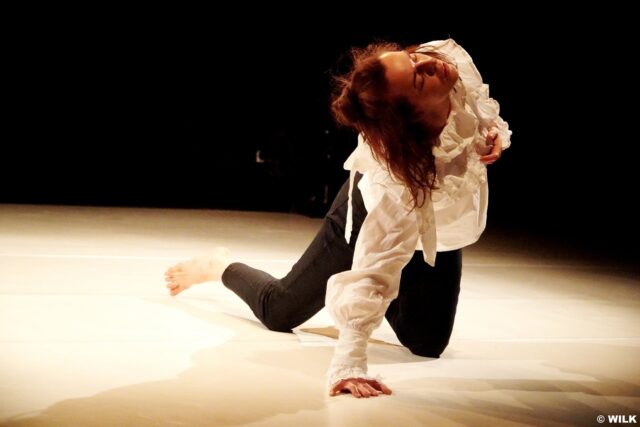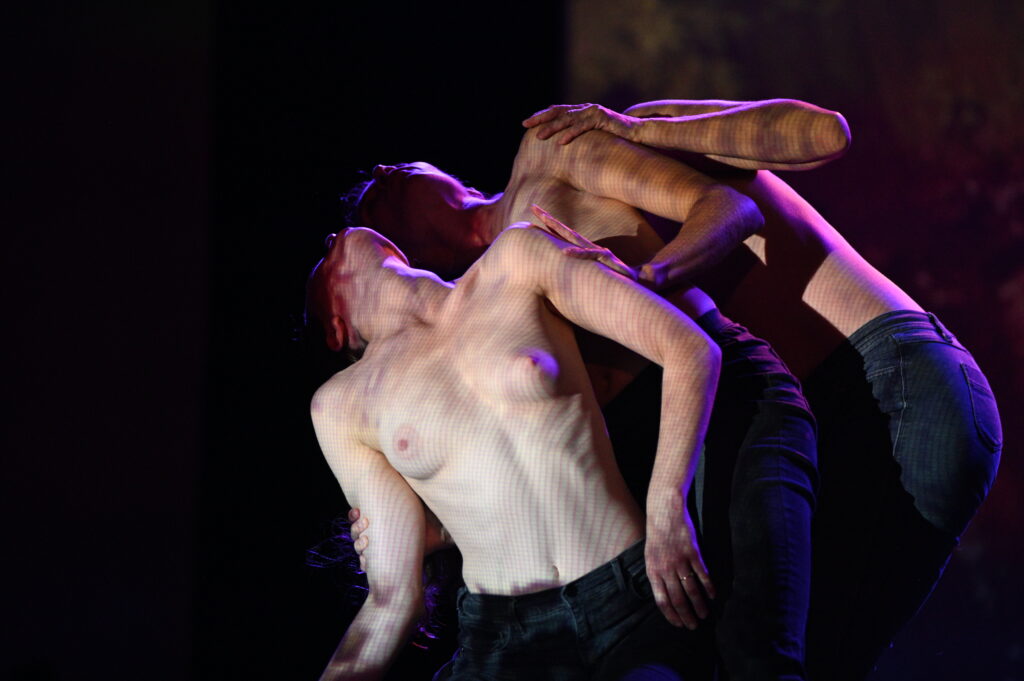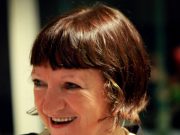
For the English version, please, scroll down
VARSAVIA – Ballerina e coreografa dello Zawirowania Dance Theatre di Varsavia, Karolina Kroczak collabora con la compagnia dal 2006 prendendo parte a numerose performance. Ha collaborato con artisti come Jaro Vinarsky, Hilke Diemer, Georg Blaschke, Juan de Torres, Daniel Abreu. In televisione, ha lavorato come coreografa in programmi quali You Can Dance. Coreografa e regista di spettacoli teatrali e progetti culturali, Kroczak è anche insegnante di numerose tecniche di danza impegnata in laboratori per tutti i livelli.
La sua coreografia di denuncia ambientale-sociale, Empty Bodies, ha affascinato il pubblico di Ra.I.D. Festivals, lo scorso 30 settembre al Palazzo Ducale Orsini di Solofra. Una performance ricca di immagini dense e dai molteplici significati.
Per la prima volta a Ra.I.D. Festivals
Il 30 settembre il pubblico di Ra.I.D. Festivals ha assistito a Empty Bodies. È la prima volta che una sua coreografia va in scena in Italia?
Sono già stata in Italia con la compagnia Zawirowania Dance Theatre, probabilmente anche con uno dei miei lavori, ma non saprei bene dire quante volte. Di sicuro è stata la prima volta a Ra.I.D. Festivals, a cui sono davvero grata per avermi invitato.
Il sottotitolo di Ra.I.D. è Dance Space Subjectivity: cosa significa per lei far danzare lo spazio?
Per me lo spazio nel contesto della danza o del lavoro sul corpo in generale non è un valore fisso, bensì qualcosa che creiamo costantemente mentre siamo in relazione con noi stessi e con gli altri. La cosa più interessante per me è l’uso della tensione tra spazio interno ed esterno, e come un ballerino può lavorare in relazione con il pubblico invitandolo a partecipare all’esperienza dello spazio, sia interno, reale che immaginato, dando significati e contesti.
Virtuose collaborazioni
Per questa edizione Ra.I.D. Festivals ha ospitato il progetto speciale Come as you are: l’arte nuda da ogni pregiudizio. Cosa ne pensa Karolina Kroczak del combinare la danza con le altre arti?
Come artista sostengo la ricerca di un linguaggio originale di comunicazione con il pubblico, in questo contesto accostare altre arti diventa ancora più interessante. Non utilizzo mai il lavoro di qualcun altro come citazione, ma cerco piuttosto di entrare in dialogo, per mostrare la mia prospettiva in relazione all’arte di qualcun altro. Succede anche che la collaborazione con artisti di altri campi dia l’opportunità di raggiungere forme o mezzi di espressione che non sono disponibili per la sola danza, anche questo crea possibilità interessanti.
Karolina Kroczak, Empty Bodies vede la partecipazione anche di Elwira Piorun, co-fondatrice dello Zawirowania Dance Theatre. Com’è stato lavorare con Piorun a questa coreografia?
Elwira ed io ci conosciamo da più di 15 anni. La apprezzo come artista, come ballerina, e abbiamo anche un rapporto personale piuttosto forte. Un arrangiamento del genere non è sempre facile, ma sicuramente la personalità di Elwira è stata di grande ispirazione per creare con lei un personaggio teatrale. Come coreografa, adoro lavorare con ballerini maturi: non solo apportano una tecnica eccellente alla performance, ma guardano anche al processo creativo in modo più aperto, almeno questo è stato il caso di Elwira.
Madre terra
In Empty Bodies le tre interpreti rappresentano, tra le altre cose, tre età della donna. In particolare, il pubblico ha assistito ad un rapporto complicato e contraddittorio tra madri e figlie. Qual è l’ispirazione che ha portato Karolina Kroczak ad affrontare questo tema?
Empty Bodies è una performance sul desiderio di connessione con la nostra natura primordiale, di vicinanza con una madre che coccola. È anche una performance sulla fame e sul vuoto, che sono il prezzo che paghiamo per un mondo ideale “di plastica”: una madre esausta che non può nutrire i suoi figli. È un mondo dove soffiano freddezza, lontananza e spazi vuoti.
Siamo sull’orlo dell’annientamento ecologico e il terreno su cui camminiamo sta diventando arido e sterile. Durante la realizzazione dello spettacolo mi ha interessato il processo di separazione, la frattura o rottura primordiale che fa sì che un organismo non si senta più parte del tutto. In questo motivo della separazione – come separazione primordiale dalla madre (compresa la madre terra) – vedo la conseguenza del degrado della natura a favore di meccanismi di produzione, sfruttamento e consumo.
Durante Empty Bodies, sullo sfondo vengono proiettate alcune foto molto suggestive: donne nude, immerse nella natura. Karolina Kroczak, come ha scelto e realizzato le immagini da proiettare?
Le immagini proiettate durante la performance sono della fotografa e artista visiva Natalia Miedziak Skonieczna, il cui progetto intitolato body-images mostra corpi femminili nudi nella natura. Mi ispiro al lavoro di Natalia in relazione al movimento come unità o appartenenza a “un certo insieme organico”.
L’intera prima parte della performance Empty Bodies è stata creata pensando ai corpi dei ballerini come un sistema, riferendosi simbolicamente al concetto di “ecosistema”. A livello di ricerca sul movimento, cercavo una comunità in questo movimento, un movimento interdipendente, ma anche il più organico possibile. Ho lavorato con l’immagine del nido, che mi ha accompagnato durante tutto il processo di creazione della performance, come simbolo della casa, qualcosa di sicuro, ma costruito anche per proteggere.
Una foto in particolare ricorda il dipinto Le cattive madri realizzato da Giovanni Segantini. Karolina Kroczak, conosce questo dipinto? Si è ispirata a questo per le foto da proiettare?
Non avevo familiarità con questo dipinto nella fase di creazione dello spettacolo, ma ho fatto qualche ricerca e ho scoperto che in realtà è molto vicino a me e al modo in cui intendo il ruolo della madre (e della terra madre) nello spettacolo.
La rottura col mondo primordiale e il degrado dei meccanismi di produzione
Altro tema di questa coreografia è la plastica: quali paralleli ci sono tra la plastica che inquina gli oceani e la chirurgia plastica?
Ho creato la performance Empty Bodies perché sono convinta che il problema dell’annientamento ecologico sia una delle sfide più grandi e importanti del mondo moderno. Ho voluto approfondire il fenomeno dello sfruttamento e del consumo sfrenato, anche affrontando questo tema nel contesto della corporeità. Già nella fase di ricerca il divario tra il corpo organico e quello soggetto a norme estetiche o sociali è diventato evidente.
Insieme ai ballerini ho deciso di trasferirmi in un mondo dove ciò che è corretto diventa attraente, dove il corpo perfetto può essere ripagato. Non solo a livello di contenuto, ma anche a livello coreografico cercavo una sorta di deformazione del movimento, è diventato chiaro che con il tempo il desiderio di rincorrere le correzioni si trasformerà in fatica, e il corpo sarà vuoto, tremante, incerto…
Un oggetto interessante in Empty Bodies è il telo di plastica. In scena assume molteplici significati: è una coperta, un abito da sposa, uno strumento musicale dal ritmo opprimente, la corda con cui Piorun lega il più giovane delle danzatrici. Karolina Kroczak, le va di raccontare qualcosa a riguardo?
Vedo la conseguenza del degrado della natura a favore di meccanismi di produzione, sfruttamento e consumo. Come simbolo di separazione ho proposto un foglio di plastica, che è diventato un attributo importante nella performance Empty Bodies. Un foglio in cui tutto può essere confezionato, avvolto, separato, rendendo ciò che è confezionato sterile, più fresco, più buono e più bello. Le esplorazioni del movimento includono compiti come il movimento di un corpo che non ha nulla da respirare, un corpo che non ha nulla su cui appoggiarsi, un senso di fame o una sensazione di eccesso di cibo.
Nella performance ho lavorato a una spirale di significato, la ripetizione degli stessi motivi: non riesco a respirare, ho fame, ho bisogno di mangiare, ho bisogno di dimagrire, ho bisogno di adattarmi questo vestito, ho bisogno di coprirmi, sto soffocando, ho bisogno di sopravvivere… Una parte importante è la videoproiezione, che mette in luce il caos in cui ci troviamo come umanità. Il ritmo del cambiamento delle immagini è il ritmo della nostra vita, il ritmo del consumo sfrenato (compreso il culto della giovinezza). Le immagini del mare di spazzatura che inonda il nostro mondo colpiscono inizialmente lo spettatore con intensità, ma col tempo diventano anche motivo di esaurimento. Così, partendo dalla plastica, ci ritroviamo in un deserto dove le forme della natura sono sempre meno visibili…

First time at Ra.I.D. Festivals
On September 30th at Ra.I.D. Festivals Empty Bodies was staged. Is this the first time that your choreography has been staged in Italy?
I’m not quite sure how many times, but we’ve been in Italy with Zawirowania Dance Theater and probably with one of my pieces, but it was for sure the first time at Ra.I.D. Festivals, which I’m really grateful for inviting my piece.
The subtitle of Ra.I.D. is Dance Space Subjectivity: what does it mean for you to make space dance?
For me, space in the context of dance or body work in general is not a fixed value, it is something we constantly create while being in relationship with ourselves and others. The most interesting thing for me is the use of the tension between internal and external space and how a dancer can work in relationship with the audience by inviting them to participate in the experience of space, both internal, real and imagined by giving meanings and contexts.
Virtuous collaborations
For this edition Ra.I.D. Festivals hosts the special project Come as you are: art naked from all prejudices. What do you think about combining dance with other arts?
As an artist I’m an advocate of finding an original language of communication with the audience, in this context combining other arts becomes even more interesting – I never use someone else’s work as a quotation, but rather try to enter into a dialogue – to show my perspective in relation to someone else’s art. It also happens that cooperation with artists from other fields gives us opportunities to reach for forms or means of expression that are not available to dance alone – this also creates interesting possibilities.
Karolina Kroczak, Empty Bodies also features Elwira Piorun, co-founder of Zawirowania Dance Theatre. What was it like for you to work with Piorun on this choreography?
Elwira and I have known each other for more than 15 years. I appreciate her as an artist, a dancer and also we have quite a strong personal relationship. Such an arrangement is not always easy, but definitely Elwira’s personality was a great inspiration to create a stage character with her. As a choreographer, I love to work with mature dancers – they not only bring an excellent technique to the performance, but also look at the creative process usually in a more open way, at least this was the case with Elwira.
Mother Earth
In Empty Bodies the three performers represent, among other things, three ages of women. In particular, we witnessed a complicated and contradictory relationship between mothers and daughters. What is the inspiration that led you to face this theme?
Empty Bodies is a performance about longing for connection with our primal nature, for closeness with a mother who cuddles. It’s also a performance about hunger and emptiness, which are the price we pay for an ideal “plastic” world: with an exhausted mother who can’t feed her children. It’s a world where coldness, distance and empty spaces blow.
We are on the verge of ecological annihilation, and the ground we walk on is becoming dry and barren. During the creation of the show, I was interested in the process of separation, the rift or primordial rupture that causes an organism to no longer feel part of the whole. In this motif of separation-already as a primordial separation from the mother (including mother earth) I see the consequence of the degradation of nature in favor of mechanisms of production, exploitation and consumption.
During Empty Bodies very suggestive photos are projected on the background: nude women, immersed in nature. How did you choose and create the images to project?
I work in performance with images by photographer and visual artist Natalia Miedziak Skonieczna, whose project titled: “body-images” shows naked female bodies in nature. I am inspired by Natalia’s work in relation to movement as unity or belonging to “a certain organic whole.”
The entire first part of the performance Empty Bodies was created under the influence of thinking about dancers’ bodies as a system, symbolically referring to the concept of “eco-system”. At the level of movement research, I was looking for a community in this movement, an interdependent movement, but also as organic as possible. I worked with the image of the nest, which accompanied me throughout the process of creating the performance, as a symbol of home, something safe, but also built for protection.
One photo in particular recalls the painting The Bad Mothers created by Giovanni Segantini. Karolina Kroczak, do you know this painting? Were you inspired by this to create the photos to project?
I was not familiar with these images at the stage of creating the show, but I did some research and discovered that they are actually very close to me and how I think about the role and situation of the mother-land in the performance.
The break with the primordial world and the degradation of production mechanisms
Another theme of this choreography is plastic: what parallels are there between the plastic that pollutes the oceans and plastic surgery?
I created the performance Empty Bodies because of my conviction that the problem of ecological annihilation is one of the bigger and more important challenges of the modern world. I wanted to take a closer look at the phenomenon of exploitation and unbridled consumption, including addressing this topic in the context of corporeality. Already at the research stage, the gap between the organic body and that which is subject to aesthetic or social norms became striking.
Together with the dancers, I decided to move to a world where what is corrected becomes attractive, where the perfect body can be paid for. Not only on the level of content, but also in the choreographic layer I was looking for a kind of deformation of movement., it became clear that with time the effort of chasing the corrections will turn into fatigue, and the body will be empty, trembling, uncertain…
An interesting object in Empty Bodies is the plastic sheet. It takes on multiple meanings on stage: it is a blanket, a wedding dress, a musical instrument with an oppressive rhythm, the rope with which Piorun ties the youngest of the dancers. Would you like to tell us something about it?
I see the consequence of the degradation of nature in favor of mechanisms of production, exploitation and consumption. As a symbol of separation, I proposed plastic foil, which became an important attribute in the performance Empty Bodies. A foil in which everything can be packaged, wrapped, separated, making what is packaged sterile, fresher, better and prettier. Movement explorations include such tasks as the movement of a body that has nothing to breathe, a body that has nothing to lean on, a sense of hunger or a feeling of overeating.
In the performance, I worked with a spiral of meaning that seems to repeat the same motifs over and over again: I can’t breathe, I’m hungry, I need to eat, I need to lose weight, I need to fit into this dress, I need to wrap up, I’m suffocating, I need to survive… An important part is the video-projection, which highlights the chaos in which we as humanity find ourselves. The pace of the changing images is the pace of our lives, the pace of unbridled consumption (including the cult of youth). The images of the sea of junk flooding our world first strike the viewer with intensity but after time they also become a reason to burn out. So as we once start with the plastic we end up in a desert where the forms of nature are less and less visible…














































